|
[Front Page] [Features] [Departments] [SGAP Home Page] [Subscribe]

Eremophilas in San Diego
Andrew Wilson
Is San Diego good Eremophila country? That depends who you ask. To a plant specialist, it should be. Like so many other Australian plants, eremophilas should find that its conditions suit them well. To a nurseryman, it is not. In fact, he probably will not have heard of them, at least, not unless he is a specialist. While they have been grown in California for many years you will not find them in many gardens. Not only are they not widely grown they are limited to a few species. However, that number is now increasing.
Eremophilas have a reputation for their toughness and ability to fend for themselves. As I will tell shortly, that toughness has to be looked at carefully. To do that, I’ll first outline the growing conditions here and limit comments to specimens in Southern California, mostly in San Diego and most of those in my own garden.
Growing conditions
At nearly the same latitude, the climates of San Diego and Perth, Western Australia are similar except that San Diego is drier. Rainfall, which occurs during the winter months, amounts to 250 mm per annum on average but every few years less than half that amount may occur. Perth, in contrast, gets about three times as much. Average summer daytime temperatures near the coast are quite temperate, about 25°C. Only 20 km further inland they are 6 to 10°C higher. The highest temperatures occur not in summer but later in the year when winds off the land are heated by compression as they pass over the mountains. In addition to causing temperatures to rise to 40°C and above the winds tend to be very strong in exposed areas and occur with extremely low humidity levels. Winters are mild, with occasional nights dropping to 0°C in the valleys and 5°C higher on the hillsides. On rare occasions frost will occur even on those hillsides.
Soils and sites are highly variable in this part of the world because of the combination of earthquake-prone mountains and resulting erosion patterns. There are some areas with red lateritic soil that are similar (to a non-geologist) to those found in parts of Western Australia. There are also areas, such as my own, where soils are very sandy and overly a clay subsoil which in places is only 0.2 meters from the surface but usually is more than a meter deep. There is little humus content in soils around here, except in the river valleys. Unlike many parts of Western Australia sloped land is common, some very steep and rocky. Water for irrigation is generally available and is usually applied with automatic sprinklers or with drip methods. While plentiful, it is highly alkaline and contains many salts.
Plants grown
The following list of species I have grown here is not the result of my choice; they were the only ones I could find to try. That is one reason why they are not commonly grown. Importation of plants is difficult and seed germination even more so.
E.maculata, in both red and yellow forms is the most commonly grown species. It can be found in nurseries that deal with Australian plants but not in the larger nursery chains. It grows well and has few faults. On my dry soils it is not easy to establish the plant. It requires care and plenty of water for a year or until its root system has gone down well below the surface. Once established, it performs reliably and flowers freely during winter and spring.
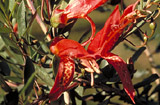 |
The red and yellow forms of the spotted emu bush, Eremophila maculata Select a thumbnail image or highlighted word for a higher resolution image [29k and 27k].
|
 |
E.gibbifolia and E.drummondii have not been successful with me. Over a five-year period they barely grew and eventually died of drought. They received water in summer twice weekly to keep them alive. I think the problem was that of establishing a deep root system. On deep, black soil in Huntington Botanic Gardens, about 150 km north of here near Los Angeles, E.gibbifolia seems to do much better.
E.calorhabdos was much more vigorous. In full sun it put out tall shoots that were covered with flowers. It is a great plant whose only problem was that rabbits liked it even more than I did.
E.glabra is accommodating gradually to conditions, showing steady but slow growth and flowering well. I have both the felty-leaved (Ouyen) as well as the typical forms. During the past year I have tried the prostrate yellow form and it seems to be quite vigorous and flowers freely. I have also seen it grow very well far north of here, in the San Francisco Bay area.
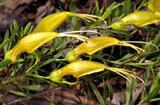 |
There are many forms of Eremophila glabra. This prostrate form is one of the most popular Select the thumbnail image or the plant name for a higher resolution image [61k].
|
E.longifolia forms a small, sturdy little bush with me. The form I have has attractive brick-red flowers. It was raised from cuttings of seedlings raised by Oz emigrant Jo O’Connell about 300 km up the coast where, in heavy, dark soil it grows much more rapidly and flowers more heavily.
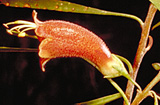 |
Eremophila longifolia is widely distributed in dry areas of all mainland states of Australia.
Select the thumbnail image or plant name for a higher resolution image (23k).
|
E.macdonnellii is one of the species that I propagated from seed. Collected nearly twenty years ago in Northern Territory by Bob Chinnock at the Adelaide Botanic Gardens some actually germinated for me, a great surprise to all. Just two years old it seems to be adapting well. Its violet flowers are most attractive.
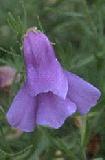 |
Eremophila macdonnellii - a widespread species from central Australia.
Select the thumbnail image or plant name for a higher resolution image (24k).
|
E.nivea grows very slowly here. A young specimen planted in spring produced no new growth until the autumn rains arrived, when the attractive new grey shoots appeared. At Huntington, in deeper, richer soils and with more rainfall it grows much larger. Here it requires summer water just to keep it alive.
E.racemosa grows slowly but flowers well and is easily propagated from cuttings. So far, it is an attractive plant here as well as in Los Angeles, about 180 km to the north.
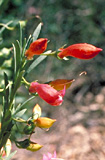 |
Eremophila racemosa is an attractive species which is at risk in the wild.
Select the thumbnail image or plant name for a higher resolution image (26k).
|
Cultivation summary
- Plants growing here appear to be quite healthy. No diseases or fungi are present. The soil is neutral but the irrigation water has a pH of nearly 8. There are no signs of chlorosis. All plants are on their own roots, but there are no signs of root rots.
- There seem to be no insect pests on any plants in the ground. The only protection they need is from rodents. In containers, however, scale sometimes appears on young plants. The reason for this difference is unclear. Perhaps container-bound plant tips are grown softer.
- Early establishment of these plants is critical to later growth. Plants that were planted in root-bound condition or were not given adequate watering in the first winter fail to become independent of the need for water in summer; plants more carefully treated have succeeded and require only limited attention.
- It is much easier to get them established in heavier soils than in sandy soils. I have given up trying to grow them on slopes where the drainage is even faster and rain accumulation less.
- In comparison with other Australian Myoporaceae (Myoporum montanum, M. parvifolium etc.) they are generally much more difficult to get started. The use of shredded leaf mulch worked into the planting region appears to help them in these poor soils. Since they come from poor soil areas in parts of Australia my suspicion derives not from the lack of nutrition but from the condition of the soil when it becomes dry. With its fine, sandy texture it becomes extremely difficult to rewet. The addition of shredded leaf mulch serves to encourage faster root development in the wet season. This may allow some of the roots to reach the underlying heavier soil where moisture is retained for longer.
Having said all that, the single biggest factor in growing them here is how they are treated in the first year. I am curious to know if this experience is different from those of Australian growers. Much of the difficulty I experienced in earlier years resulted from applying too literally the cultivation comments in "Australian Plants for Western Queensland", a Planting Guide. This short publication was put out by the Queensland Forestry Dept. over fifteen years ago and references "The Use of Trees and Shrubs in the Dry Country of Australia". While directions on the establishment of acacias, mallees and melaleucas in arid areas of Australia turned out to work well here the same was not true for eremophilas. They simply required more attention as infants. Perhaps, starting life in cutting rather than seedling form, gave them root systems that went down for water less vigorously. If true, this will be a tough problem to overcome.
In fairness, my soil conditions are drier than most. Not only is the soil sandy but it contains fine sand grains. When the soil dries out it becomes like powder and, as pointed out above, is difficult to moisten. Humus does make that moistening process easier. In one garden I know (further north with double the rainfall, at least) where planting was done in good soil in a built-up bed with a heavy mulch the growth rate in the first year is much better than I have seen.
With the exception of E. calorhabdos and E.macdonnellii, all plants here were grown from cuttings. The planting of seedlings was more successful, I believe, because they could send down long roots while young. Cutting-grown plants are now being watered in winter to encourage such root growth.
Once established, eremophilas here have proven to be tough and tolerant of garden conditions (no rodents) and accept both a certain amount of neglect as well as of care (being trimmed). They flower for many months if given water. They are not worried by either our dry or hot conditions provided they can form a deep root system. They do not object to the alkaline water and appear to need it for a few years. From the nearly two hundred species occurring in poor and arid conditions it seems likely there are a number that would be even better garden plants than those few described above.
Andrew Wilson, a member of the West Australian Wildflower Society for over ten years, lives in San Diego, California. A physicist by training and a horticulturist by avocation, he has planned and created gardens in Ireland and California. A lifelong theme carried out in those informal gardens was to grow plants that accept local conditions without the need for heroic measures. In Ireland they were Chilean and New Zealand plants, in California they are Australian, South African and Californian natives.

[Front Page] [Features] [Departments] [SGAP Home Page] [Subscribe]
Australian Plants online - March 1999
The Society for Growing Australian Plants
|